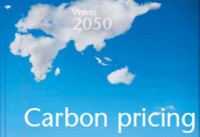Do you really understand Carbon Pricing?
 In 2010 the World
In 2010 the WorldBusiness Council for Sustainable Development (WBCSD) released its
target=”_blank” title=”Vision 2050”>Vision 2050 report, which
laid out a pathway leading to a global population of some 9 billion
people living well, within the resource limits of the planet by
2050.
In its scenario for a sustainable future, Vision 2050,
the WBCSD identified a “carbon price and increased use of other
forms of true-value pricing” as a 2020 “must have”. A
carbon price is a value that reflects the impact of CO2 emissions
from the product or service on the environment.
Establishing a carbon price, implicitly
or explicitly, is potentially one of the most powerful mechanisms
available to reduce national greenhouse gas
emissions.
We need pricing for goods and services that includes their full
cost and benefits - economic, social and environmental, argued the
WBCSD.
A new issues brief,
target=”_blank”>Carbon Pricing: The Role of a Carbon Price as a
Climate Change Policy Instrument, has been released by
WBCSD intended as a easy to read guide to reinforce the
business case and the economic rationale for establishing a price
on carbon emissions.
The Issues Brief stresses that in the wake of a deep recession,
and in the midst of a tough political environment, governments
without a comprehensive climate policy may look to a variety of
proxy approaches to deliver emission reductions across the
economy.
These will certainly deliver some results, but matching the
efficiency and order imposed by establishing a market-responsive
approach will be difficult and will also cost the economy more than
is necessary.
Business requires clear signals towards a low carbon economy,
and a level playing field across international markets, argues
WBCSD. This can best be achieved through global and stable
carbon prices. Determined support for global carbon pricing
would be the most efficient way to curb global carbon
emissions.
Carbon Pricing as a climate change policy
instrument
A “carbon price and increased use of other forms of
true-value pricing” is one of the deliverables necessary by 2020 in
WBCSD Vision 2050, a scenario for a sustainable future.
Establishing a carbon price, implicitly or explicitly, is
potentially one of the most powerful mechanisms available to reduce
national greenhouse gas emissions.
The goal of carbon pricing is to create a change in the economy,
whereby the market begins to differentiate between goods and
services on the basis of their carbon footprints.
The Issues Brief -
target=”_blank”>Carbon Pricing: The Role of a Carbon Price as a
Climate Change Policy Instrument - is available for
download.
You can return to the main Market News page, or press the Back button on your browser.

